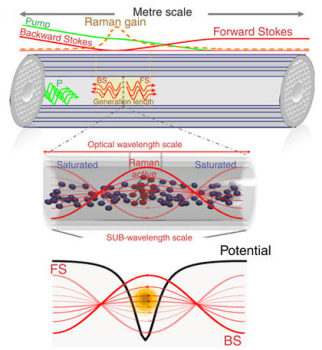Feb 9 2017
One significant aim in precision spectroscopy refers to reducing the emission linewidth from a molecule. Cooling molecules to near absolute zero is one approach that can be considered. An alternative approach is to localize the molecules on subwavelength scale. The use of a standing wave in a gas-filled hollow fiber is treated to be a novel approach in this direction. This novel approach develops an array of deep, nanometer-scale traps for Raman-active molecules, thus resulting in linewidth narrowing by a factor of 10 000.
 On the macroscopic scale, the pump light transforms into forward-propagating Stokes (FS) radiation, which is partially reflected from the fibre end and becomes backward-propagating Stokes radiation (BS) which is also amplified by the pump. In the region where both FS and BS are strong, they form interference pattern of standing wave, which is shown on the microscopic scale. In the low-field regions (denoted by red-color molecules) the molecules are in the ground state and strongly trapped, as shown by the potential in the bottom panel. Exactly these trapped molecules are Raman-active, leading to line narrowing. Credit: MAX � BORN - INSTITUT
On the macroscopic scale, the pump light transforms into forward-propagating Stokes (FS) radiation, which is partially reflected from the fibre end and becomes backward-propagating Stokes radiation (BS) which is also amplified by the pump. In the region where both FS and BS are strong, they form interference pattern of standing wave, which is shown on the microscopic scale. In the low-field regions (denoted by red-color molecules) the molecules are in the ground state and strongly trapped, as shown by the potential in the bottom panel. Exactly these trapped molecules are Raman-active, leading to line narrowing. Credit: MAX � BORN - INSTITUT
The radiation released by molecules and atoms is generally broadened because of the motion of the emitters, which gives rise to the Doppler effect. Overcoming this broadening is a complicated tack especially in the case of molecules. Constructing deep potential traps with tiny dimensions is one way to overcome the molecular motion. This was earlier carried out e.g. by arranging many counterpropagating beams in a complex setup, with limited success.
Researchers, in a collaborative effort of the Max Born Institute (A. Husakou) and Xlim Institute in Limoges, demonstrate that self-organization of Raman gas (molecular hydrogen) in a hollow photonic crystal fiber allows subwavelength localization and line narrowing in a very simple arrangement. Raman scattering allows the continuous-wave pump light to change into the so-called Stokes sideband, which moves back and forth in the fiber because of reflections from the fiber and then produces a stationary interference pattern, which is a standing wave with interchanging regions of high and low field. The Raman transition is not active but saturated in the high-field regions, and the molecules contain high potential energy as they are partially in the excited state. The molecules are Raman-active in the low-field region, and low potential energy is present in them as they are near to the ground state. An array of approximately 40 000 strong, narrow traps, containing localized Raman-active molecules, is developed by low-field regions. The size of these traps is almost 100 nm (1 nm = 10-9 m), which indeed is a lot smaller than the light wavelength of 1130 nm. Thus, the emitted Stokes sidebands comprise of an extremely narrow spectral width of just 15 kHz - this is 10 000 times narrower than the Doppler-broadened sidebands for the very same conditions.
Manifestation of the self-organization of the gas also takes place on the macroscopic scale. First, the calculations reveal that the Raman process mostly happens exactly in the fiber section where the standing wave is developed. Second, the macroscopic gradient of the potential results in the gas flowing towards the fiber end, which is observed in the experiment. This strong localization and the linewidth narrowing can find a wide range of applications, for e.g. in spectroscopy. However, it can further be used as a method to occasionally modulate the density of the gas, which is usually ideal for developing quasi-phase-matching schemes for various other processes, such as effective generation of high harmonics.